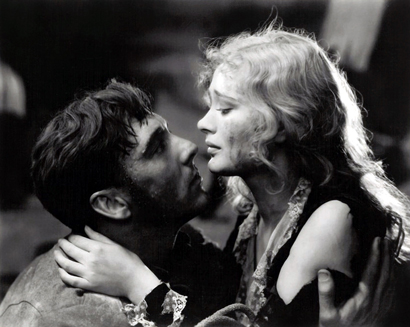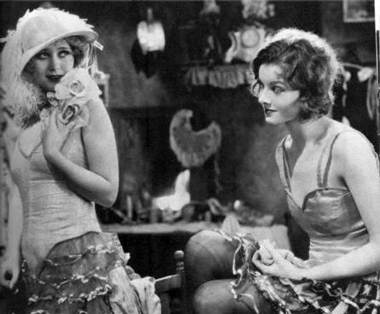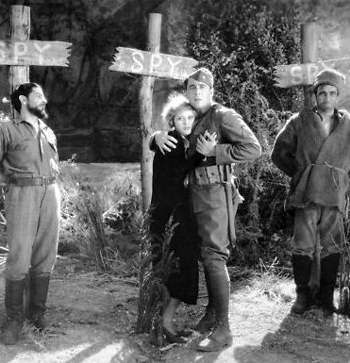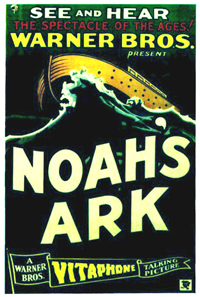
 |
|
|
|
A bare description makes Noah's Ark sound like a really bad idea for a movie, but in execution it has a giddy simplicity that's difficult to shake off. Seemingly based as much on silent Italian super-productions as anything from the Bible, it remains an eye-opening spectacle. The flood scenes look dangerous because they were dangerous: cameraman Hal Mohr quit the film when he saw inadequate preparations for the safety of the hundreds of extras. The movie carries the 1928 equivalent of top star power: Dolores Costello is a timeless beauty who could easily be a star today, and George O'Brien has the heroic physique of a Cinecittà muscleman. Just getting started in Hollywood, Michael Curtiz's direction is both exciting and artful. The film flaunts more than its share of "did you see that?" spectacle, and nurtures a tidy romance at its center. Actually, two tidy romances, between the same two actors. 
Darryl Francis Zanuck devised the trick plotline, which could have been invented by Singin' in the Rain's Cosmo Brown. The story is split between the well-known account of Noah's Ark (with romantic embellishments) and a drama that plays out over five years in WW1, which in 1928 was still considered by some to be "the war to end all wars". Disasters seem to be the common currency in human life. A train wreck just inside France just as war breaks out leaves German fraulein Mary (Dolores Costello) in the hands of Americans Travis (George O'Brien) and Al (Guinn "Big Boy" Williams). Rescuing Mary from the destruction, they must protect her from the lecherous Russian officer Nickoloff (Noah Beery). Travis and Mary fall in love in Paris. They become man and wife but eventually part when Travis feels duty bound to enlist to fight in the trenches. Mary becomes an entertainer for the troops but is spotted by Nickoloff again. The unscrupulous Russian insists that she spend the night with him. When she attempts to flee he frames her as an enemy spy, to be shot at dawn. The above "modern" part of the story is intercut (in large chunks) with the story of the Ark. Noah (Paul McAllister) defies the pagan god of evil King Nephiliu (Noah Beery) and has his three sons construct the mighty vessel. Jehovah protects the Ark from a mob by hurling lightning and fire upon them. For a major sacrifice, Nephiliu's guards seize Miriam (Dolores Costello), the virgin intended of Noah's son Japheth (George O'Brien). When Japheth demands her back, he's blinded and chained to slavery on a stone grinding wheel until he dies. Noah brings all the animals of the world onto the Ark, trusting Jehovah's word that his loved ones will be protected. As Nephiliu's archers prepare to sacrifice Miriam, dark clouds gather... What sounds like an out-of-control plotline holds together through a basic melodramatic appeal -- we want to see how the WW1 episodes relate to the Great Flood. Darryl Zanuck's storyline takes a moral position that hasn't dated. We first see the Europeans on the train to doom, all engaged in their secular pursuits as Frenchmen and Englanders on holiday, or others who sell arms. Common to both stories is a holy man. When the main characters are buried in a church basement after a German bombardment, the preacher speaks, telling the tale of Noah's Ark to finish the bulk of the Biblical story. 
Noah's Ark is a part talkie: most of the film operates as a normal silent but several scenes use the new Vitaphone sound-on-disc system. Mary and Travis sit on a park bench and converse for a couple of minutes, that sort of thing. One of the speaking roles goes to a young Myrna Loy, as a fellow cabaret dancer with Dolores Costello. The movie also has an elaborate and dramatically impressive orchestral score. Many isolated sound effects are added to synch up with the action, and a number of songs don't exactly synch but are properly timed. 1928 was a strange transitional year for movie audio, with projectionists forced to cue up the large Vitaphone discs, hoping that they'd stay in synch. The ancient story clearly cost a bundle, with excellent special effects used to show the Ark filling with animals, the fury of Jehovah's thunderbolts, the destruction of Nephiliu's temple and the submersion of the entire earth. Superimpositions account for some spectacular shots but the key scenes of the pagans being washed away and their temple destroyed are accomplished on huge sets, onto which are dumped huge volumes of water. While Miriam stands tied to her sacrificial altar like Fay Wray, costumed actors and stuntmen are knocked off their feet and dashed against the scenery as enough water to fill a swimming pool comes crashing in, wave after wave. It's all very real. By all accounts three extras were drowned (is that all?) and many more suffered broken limbs. Director Michael Curtiz was an "everything for the shot" guy who left details like common sense safety to others to worry about; it's a sure thing that the Brothers W. reconsidered their practices after this picture. MGM apparently drowned a number of extras shooting the silent Ben-Hur, but that was in Italy, far away from home. The Noah's Ark fatalities may have been the prime inspiration for the opening calamity in Nathaneal West's famous novella The Day of the Locust. 
Dolores Costello stands tall and strong against the heavenly deluge, looking both Bible-virtuous and sexy as all get-out. The surprise is George O'Brien. An unusually handsome star, O'Brien's Japheth fits the description of a modern muscleman hero. Although blinded, Japeth frees himself from the shattered stone and walks through the floods and mayhem to rescue Miriam, and carry her all the way back to the Ark, where more miracles ensue. In 1928 Japheth's actions must have been modeled after those of the hero Maciste, the protector of a princess in the silent Italian epic Cabiria. O'Brien and Costello make very attractive romantic leads in each of their double roles. These seemingly unrelated filmic sections are united in the conclusion, where the Armistice is treated as a new beginning of hope for Peace and virture in the modern world. The war has already been depicted as a flood of human blood drowning Europe in death. This comparison doesn't really align, as Jehovah's flood was a good thing (?) that wiped out sin and iniquity, whereas only a fool would think that the slaughter of the trenches did anybody any good. What does work is Noah's Ark's expression of optimism that the Armistice might really be the end of War. Such an idea is unrealistic and perhaps even counterproductive, considering the slaughter that continued in other parts of the globe throughout the 1920s. But it beats the finger-pointing and isolationism of a number of pacifist epics that claim a higher moral ground, prescribing radical politics or religious revivals as the cure-all for the world's ills. 1 
The Warner Archive Collection DVD-R of Noah's Ark is a very good transfer of this eye-opening relic from the silent era. It was cut by half an hour right after its premiere engagement; we're told that a number of sync-sound sermons were taken out. As it is now, both Noah and the WW1 preacher's good words are handled through intertitles. Noah receives Jehovah's instructions to build the Ark by way of writing magically burned into rock tablets. 
The picture has its dings and flaws but is mostly in great shape, with Hal Mohr's lighting looking particularly good. The presentation contains several minutes of curtain music fore and aft, an addition to the film's orchestral score that incorporates the sentimental tune "Heart o' Mine", sung as if through a megaphone Viewers will note that the image is cropped. Vitaphone sound-on-disc systems didn't need a soundtrack area on the film itself, so original prints of Noah's Ark filled the full Silent Aperture. When later sound-on-film prints were struck, the film image wasn't made smaller before the soundtrack was laid down. This common problem leaves the entire movie with a rather tightly cropped left side, and slight trims top and bottom. And that's all that exists. We only notice it on close-ups and two-shots, where compositions seem to be overweighted to the left side of the frame. I've been reviewing a number of Biblical epics of late and wasn't expecting Noah's Ark to be so entertaining. I wonder if silent-era audiences thought it a worthy picture. We're told that the sober silent version of The Ten Commandments and The King of Kings were received almost as sacred items, as if the filmmaker Cecil B. DeMille were obeying God's will and not making entertainments for money's sake. He, of course, would soon enough turn the genre toward "pious exploitation" with his hypocritical Pre-Code epic The Sign of the Cross.
On a scale of Excellent, Good, Fair, and Poor,
Noah's Ark rates:
Footnotes:
1. Noah's Ark fits nicely into a pattern of religious filmmaking proposed by critic Ivan Butler, yet stays clear of its excesses. The big upswings in Biblical-political movies came with technological advances. The advent of the movies led many filmmakers of the 'teens to make shows that promoted Judeo-Christian values as the savior of humanity. Later trends in the same direction followed the popularity of revivalism on the radio -- the late '20s -- and TV -- the early 1950s. In each time period, some filmmakers added bizarre political content to the brew -- pro-Fascism in the early 1930s and anti-Communism in the 1950s. Extreme pictures along these lines once tended to be relatively obscure, but that's no longer the case. Today fundamentalist religious content shouts for attention almost everywhere in the media, and is almost always combined with conservative politics.
Reviews on the Savant main site have additional credits information and are often updated and annotated with reader input and graphics. Also, don't forget the 2010 Savant Wish List. T'was Ever Thus.
Review Staff | About DVD Talk | Newsletter Subscribe | Join DVD Talk Forum |
| ||||||||||||||||||